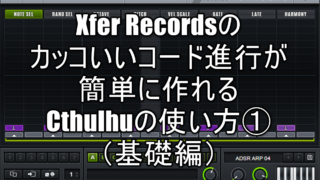How to use Cthulhu to easily create cool chord progressions in Xfer Records ③ (Practice)
I was able to understand the Oita specifications by writing explanations of the parameters.
Previously at allCthulhuI didn't understand the goodness of.
After all, you should read the manual.
Please refer to the previous article for basic setting usage.



In this article, I will go on without touching on the basics.
That's why I will send you the following contents this time.
-Switch Cthulhu patterns via MIDI
Play Bass using Cthulhu's ARP function
Cthulhu is pretty easy to play the bass.
If you play "1" in ARP, the fundamental tone will sound, so all you have to do is set the timing and you will hear a super-simple bass.
After that, if you like, you can mix "2", "3", and other "OCTAVE" to make a bass in no time.
Add the drums and pads and you'll get something like this right away.
If you want to make it look a little strange, click "RAND" to randomly generate it, and you can easily create patterns that you can't think of.
If there is a problem with the pitch, you can adjust it by changing "OCTAVE" or specifying "-12" in "TRANSPOSE".
The base is freePendulate, PadVirtual CZ, The drums are from UJAMVICE.
Switch Cthulhu patterns via MIDI
This pattern switching is much easier to use in Cthulhu than in Phrasebox.
Unfortunately, Phrasebox needs to switch patterns with MIDI CC, but Cthulhu can switch with MIDI notes.
And it is possible to switch in the middle, and it is possible to play other ARP patterns a little.
ARP pattern switching is C0 (A) to B0 (L) for FL Studio.
(I think other DAWs were about two octaves higher)
You can do the following by switching the ARP pattern.
How to use Cthulhu to easily create cool chord progressions in Xfer Records ③ (Practice) Summary
I'm doing it on a base this time, but if you do it with a synth, you can make as many riffs as you like.
It's a good idea to make the melody yourself, and use Cthulhu to make the riffs that sound in the back and the riffs that sound in the intro.


![[Free] ZODIAC Beta Sample Pack released by Cymatics 17 2021 01 29 13x54 13](https://chilloutwithbeats.com/wp-content/uploads/2021/01/2021-01-29_13h54_13.png)
![[Free] Kontakt sound source for cajon and bongo, The New Cajon and Bongo, is distributed free of charge on 8dio 18 2021 02 01 20x59 19](https://chilloutwithbeats.com/wp-content/uploads/2021/02/2021-02-01_20h59_19.png)
Comment
At first glance, I didn't really understand how good it was, but it's much better than I expected, Cthulhu.
There is a DTM that you can see the goodness by reading the manual w
I also read almost all pages of the manual for the plug-ins that I mainly use, but I can't load plug-ins that use only specific functions or those that are used infrequently ...
The story changes, but looking at the content of this article, I will write it because it seems that the explanation of how to use Captain Melody was omitted.
In the previous comment, I mentioned that the Captain Plugins bass plugin cannot be used as a simple preset collection, but you can actually make a bass with Captain Melody.Or rather, I make it with Melody.
How to make is almost the same as how to make the base of this article. Captain Melody is a plug-in that generates a melody that follows the chords of Captain Chords, so its operating principle is similar to ARP functions such as Cthulhu.
The difference from Cthulhu is that Cthulhu is based on the constituent notes of the chord, while Captain Melody randomly generates from the 7 notes corresponding to the chord, so it is possible to generate other than the constituent notes of the chord.
And since you can play with this generation probability, if you increase the generation probability of the note that matches the root of the code and set it to suppress the swing width of the note, you can make a good base just by pressing the random button. ..
Furthermore, since the rhythm can be freely recorded by pressing the record button, triplets and doublets can also be used, and more complicated patterns can be intuitively generated than switching ARP patterns with Cthulhu. ..
Since it can not be controlled by MIDI, it seems that Cthulhu will be better off using patterns, but when I saw Cthulhu being used like this time, I thought that Captain Melody would be more suitable.
Thank you for your comment!
> There is a DTM that you can see the goodness by reading the manual w
That's true.
I had Cthulhu itself for quite some time, but I decided that I couldn't use it so much and left it alone ... The manual is important ~
Thank you for the information on Captain Melody.
I see, you can also make a bass with Captain Melody.
> And since you can play with this generation probability, if you increase the generation probability of the note that matches the root of the code and set it to suppress the swing width of the note, you can make a good base just by pressing the random button. increase.
It's nice to be able to adjust the generation probability!
I think the longest pattern is that Cthulhu, Phrasebox, and Captain Melody each have their own strengths, and in the end, all of them are aligned and the tools used are changed each time.
> Since it cannot be controlled by MIDI, it seems that Cthulhu will be better off using patterns, but when I saw Cthulhu being used like this time, I thought that Captain Melody would be more suitable.
Pattern selection is strong with MIDI notes.
I can't do it with Phrasebox, so I have to use Cthulhu more.
(Although riffs including chords will be given to the Phrasebox)
But I can't wait for the Captain Melody sale!